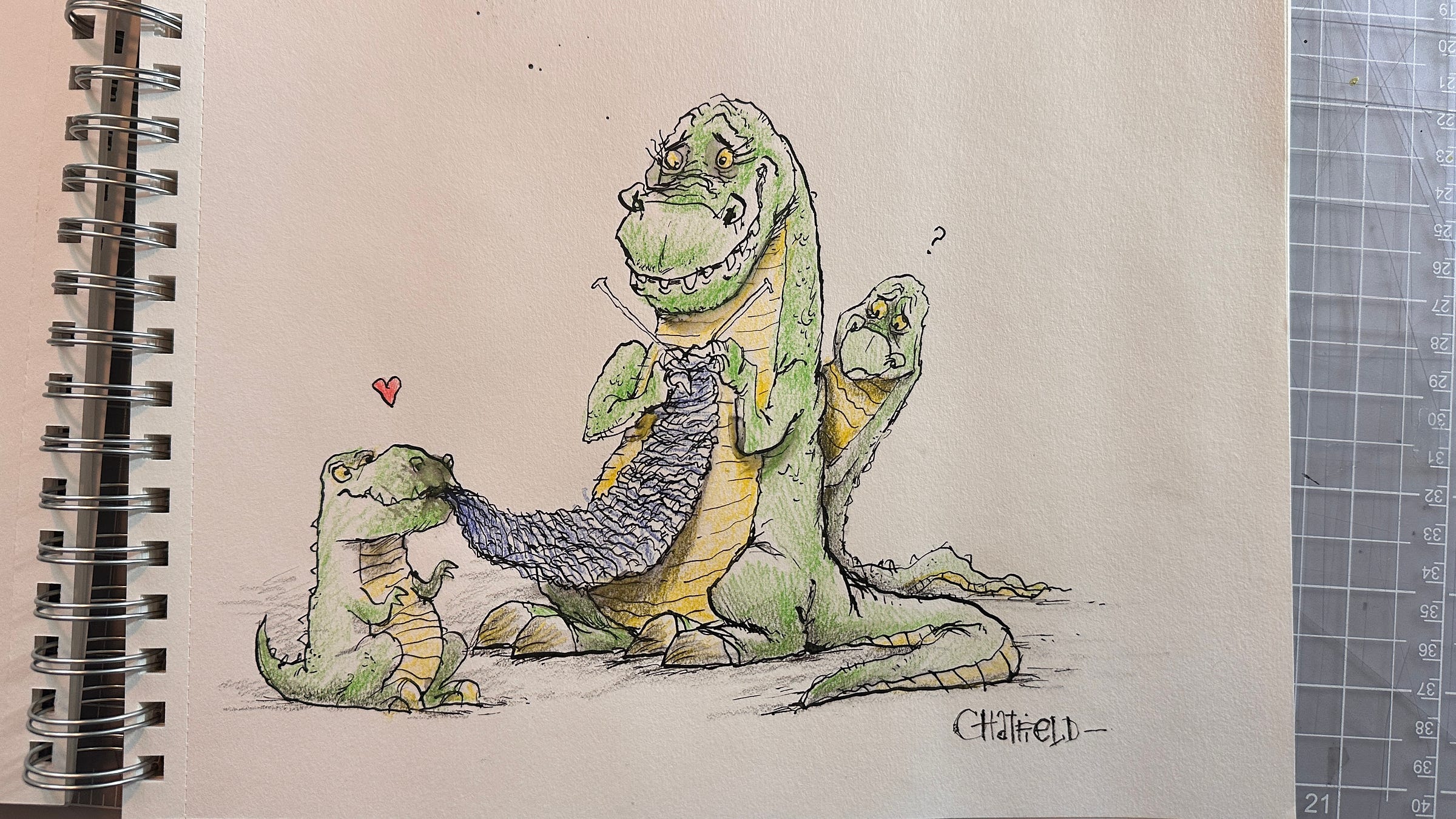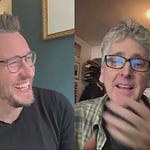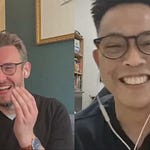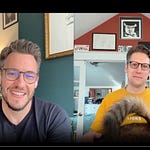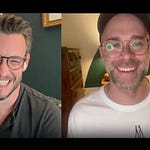Thank you
, , , , , and many others for tuning into my live video withJoin me for my next live video in the app on Thursday, May 29 with from The SneakyArt Post
Drawing Lessons and Life Lessons: My Chat with Adam Ming
Yesterday, I had the pleasure of talking with
, the talented illustrator and prolific mind behind one of the best creative daily newsletters on Substack: Ten Minute Artist - Daily Creative Joy.We covered everything from his circuitous journey as an artist, his cartooning influences growing up in Malaysia, to the practical realities of building a creative career, all while attempting to draw a dinosaur knitting a scarf (his came out way better than mine, naturally).
From Comic Strips to Picture Books
Adam's path to illustration success wasn't exactly what you'd call a straight line. After art school, he did the classic post-graduation dance of "all kinds of other jobs" - selling luxury cars, working in startups, basically anything that wasn't illustration. It wasn't until he was staring down the barrel of 40 during COVID that he had his moment of clarity: "I realized and I remembered, hey, I wanted to be an illustrator. And I'm going to be 40, and if I don't do it now, I'm going to be 50. And then how is that going to feel?"
Here's what I like about that— all that seemingly unrelated experience actually informed his creative approach. His time at Stanford learning about startups gave him something most artists don't have: a systematic way of thinking about creative work. "You learn the systems and you can actually apply them to what you do as an illustrator." Who knew that understanding minimum viable products could help with picture books?
The pivot from aspiring cartoonist to picture book illustrator came through what I think is a genuinely brilliant observation. After seeing John Klassen's "I Want My Hat Back," Adam had this lightbulb moment: picture books were basically comic strips in book form. "It felt like hey, this is the same art form I was looking for - sequential art. And newspapers are dying, but this is growing." Sometimes the best career moves come from recognizing that the thing you want to do already exists - it's just wearing different clothes.
The Reality of Creative Discipline
One of the key moments in our conversation came when Adam talked about sacrifice; When he decided to become an illustrator, he counted the hours he spent doing different things to carve out time for his art. "I needed to find the time. So one of the things I did was count how many hours I spent playing FIFA, about 500 a year. And so that had to go."
This led to a broader discussion about attention and time management. Adam shared a James Clear quote that clearly resonates with him: "The more control you have over your attention, the more control you have over your future. And it starts with having enough courage to protect your time."
Related Reading:
We talked about how this principle extends beyond just finding time to create. Adam's Ten Minute Artist - Daily Creative Joy concept stems from this philosophy: "If you wanted to start and everyone says they want to start, then start with 10 minutes and then you can scale that... But if you're not even doing it daily, it's not going to happen."
On Individual Voice and Bearing Pain
We then discussed what it takes to develop an authentic creative voice. Adam shared a Murakami quote that has clearly shaped his thinking:
"In order to be an individual, you have to be able to bear emotional pain."
This isn't abstract philosophy - it has real, practical applications. For years, I was "chameleonic" in my work, adapting my style to whatever clients wanted. The pain came in learning to say no, to turn down work that didn't align with his vision. "I started turning down work because I was like, this just isn't me. Yes, I can do this, but I won't do this."
The result? People actually respected the boundaries. "I thought they would hate me for it, and I was ready to bear a bit of pain... But for the most part, people are just respectful."
The Stand-Up Connection
What fascinated me was how much Adam's approach to illustration has been influenced by stand-up comedy, particularly Steve Martin's "Born Standing Up."—my favourite autobiography from a comedian. He sees parallels between the discipline required in comedy and in building an artistic practice.
We discussed the ridiculous story about Steve Martin performing to an empty room because the venue owner said people would see through the windows and come in. As Adam noted, "People think that you need like thousands of people following you before you do your thing. You start doing it for nobody, and you do it again and again and again."
Related: See my review of Born Standing Up here.
On Talent and Persistence. Also, tennis. 🎾
One insight that particularly stuck with me was Adam's take on talent, inspired by Maria Sharapova: "The thing that makes her great was the fact that she doesn't get bored. She can hit that tennis ball against the wall for 12 hours straight, and I think that is talent... People think talent is some magical thing. It's just this ability to not get bored and just do the thing regardless."
This connects back to his core philosophy about how creative careers are built: "How you spend a day is how you spend your life. So if you're not doing it daily, it's not going to happen."
Drawing Together
The second half of our conversation involved actually drawing together - a dinosaur knitting a scarf, as requested by viewer Amy (thanks for the suggestion, Amy!). While I wrestled with my Hunt 101 dip pen like it was a stubborn piece of furniture I was trying to assemble without instructions, Adam effortlessly created this gorgeous feathered creature with his glass dip pen. Watching him work while discussing the balance between control and chaos in the creative process was both genuinely inspiring and mildly humiliating. His line work has this incredible fluidity that makes my dinosaur look like it was drawn by someone wearing oven mitts.
Listen to this episode with a 7-day free trial
Subscribe to New York Cartoons to listen to this post and get 7 days of free access to the full post archives.







